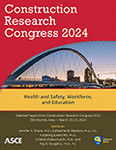Construction Workers’ Behavioral Intention toward a Passive Back-Support Exoskeleton: Application and Extension of UTAUT Model
Publication: Construction Research Congress 2024
ABSTRACT
Exoskeletons are promising solutions to address the prevalence of back injuries in the construction industry. However, scarce evidence is available regarding the acceptance of exoskeletons among construction workers. Using the unified theory of acceptance and use of technology (UTAUT) model, this study explored construction workers’ intention to use an exoskeleton. A field study was conducted wherein pipe and concrete workers performed construction tasks with a passive back-support exoskeleton. Data on workers’ perceived usability, discomfort, exertion, safety, and social influence from using the exoskeleton were collected. Spearman’s correlation analysis indicates a strong correlation between perceived ease of use, comfort, performance, safety and social influence, and workers’ intention to use the exoskeleton. However, discomfort and exertion did not have an impact on workers’ behavioral intentions. The findings of this study contribute to the UTAUT model and provide evidence on the drivers of workers’ acceptance of passive exoskeletons in the construction industry.
Get full access to this article
View all available purchase options and get full access to this chapter.
REFERENCES
Anwer, S., Li, H., Antwi-Afari, M. F., and Wong, A. Y. L. (2021). “Associations between physical or psychosocial risk factors and work-related musculoskeletal disorders in construction workers based on literature in the last 20 years: A systematic review.” International Journal of Industrial Ergonomics, 83, 103113.
BLS. (2023). “IIF Databases : U.S. Bureau of Labor Statistics.” <https://www.bls.gov/iif/data.htm>.
Elprama, S. A., Vannieuwenhuyze, J. T. A., De Bock, S., Vanderborght, B., De Pauw, K., Meeusen, R., and Jacobs, A. (2020). “Social Processes: What Determines Industrial Workers’ Intention to Use Exoskeletons?” Human Factors, 62(3), 337–350.
Gonsalves, N. J., Akanmu, A. A., Gao, X., Agee, P., and Shojaei, A. (2022). “Industry-Perception of the Suitability of Wearable Robot for Construction Work.” Journal of Construction Engineering and Management, 149(5), 04023017.
Gonsalves, N. J., Ogunseiju, O. R., Akanmu, A. A., and Nnaji, C. A. (2021). “Assessment of a passive wearable robot for reducing low back disorders during rebar work.” ITcon, 26, 936–952.
Goldsheyder, D., Weiner, S. S., Nordin, M., and Hiebert, R. (2004). “Musculoskeletal symptom survey among cement and concrete workers.” Work, 23(2), 111–121. https:// .ncbi.nlm.nih.gov/15502291.
Hensel, R., and Keil, M. (2019). “Subjective Evaluation of a Passive Industrial Exoskeleton for Lower-back Support: A Field Study in the Automotive Sector.” IISE Transactions on Occupational Ergonomics and Human Factors, 7(3-4), 213–221.
Kim, H. K., Hussain, M., Park, J., Lee, J., and Lee, J. W. (2021). “Analysis of Active Back-Support Exoskeleton During Manual Load-Lifting Tasks.” J. Med. Biol. Eng., 41(5), 704–714.
Kim, S., Moore, A., Srinivasan, D., Akanmu, A., Barr, A., Harris-Adamson, C., Rempel, D. M., and Nussbaum, M. A. (2019). “Potential of Exoskeleton Technologies to Enhance Safety, Health, and Performance in Construction: Industry Perspectives and Future Research Directions.” IISE Transactions on Occupational Ergonomics and Human Factors, 7(3-4), 185–191.
Kropf, D. C. (2018). Applying UTAUT to determine intent to use cloud computing in K-12 classrooms. Walden University. Available from ProQuest Dissertations & Theses Global. (2041902184). http://login.ezproxy.lib.vt.edu/login?url=https://www.proquest.com/dissertations-theses/applying-utaut-determine-intent-use-cloud/docview/2041902184/se-2.
Qu, X., Qu, C., Ma, T., Yin, P., Zhao, N., Xia, Y., and Qu, S. (2021). “Effects of an industrial passive assistive exoskeleton on muscle activity, oxygen consumption and subjective responses during lifting tasks.” PLOS ONE, 16(1), e0245629.
Siedl, S. M., and Mara, M. (2021). Exoskeleton acceptance and its relationship to self-efficacy enhancement, perceived usefulness, and physical relief: A field study among logistics workers. Wearable Technologies, 2. E10.
Siedl, S. M., and Mara, M. (2022). “What Drives Acceptance of Occupational Exoskeletons? Focus Group Insights from Workers in Food Retail and Corporate Logistics.” International Journal of Human–Computer Interaction, 0(0), 1–10.
Venkatesh, V., Morris, M. G., Davis, G. B., and Davis, F. D. (2003). “User Acceptance of Information Technology: Toward a Unified View.” MIS Quarterly, 27(3), 425–478. https://doi.org/10.2307/41410412.
Zhu, Z., Dutta, A., and Dai, F. (2021). “Exoskeletons for manual material handling – A review and implication for construction applications.” Automation in Construction, 122, 103493.
Information & Authors
Information
Published In
History
Published online: Mar 18, 2024
ASCE Technical Topics:
- Business management
- Concrete pipes
- Construction engineering
- Construction industry
- Construction management
- Employment
- Engineering fundamentals
- Field tests
- Human and behavioral factors
- Infrastructure
- Labor
- Occupational safety
- Personnel management
- Pipeline systems
- Pipes
- Practice and Profession
- Public administration
- Public health and safety
- Safety
- Social factors
- Tests (by type)
Authors
Metrics & Citations
Metrics
Citations
Download citation
If you have the appropriate software installed, you can download article citation data to the citation manager of your choice. Simply select your manager software from the list below and click Download.
